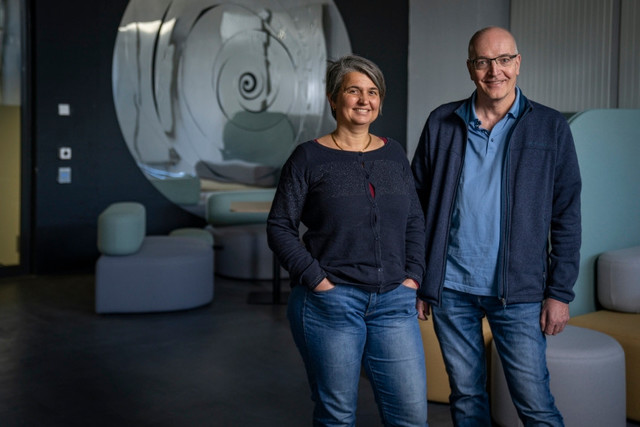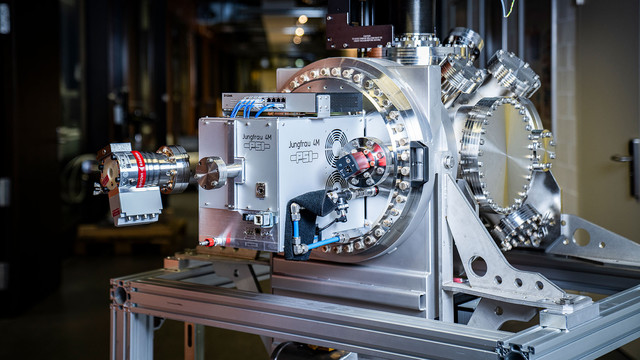Developing detectors to transform science with light (part 2)
Part II: Why detecting soft X-rays is hard, and how a new breakthrough is set to transform low energy X-ray science.
Read part I of the detectors story here.
The Jungfrau detector was developed for the hard X-ray beamline of the X-ray free electron laser SwissFEL and is used by XFELs worldwide. Now, for the soft X-ray beamline of SwissFEL, the detector group are advancing it to climb a new peak: low X-ray photon energies. The technology is set to transform soft X-ray science not only at free electron lasers, but at SLS 2.0 and synchrotrons throughout the world.
(Photo: Paul Scherrer Institute/Mahir Dzambegovic)
(Photo: Paul Scherrer Institute/Mahir Dzambegovic)
“In the same way that our single photon counting detectors became a must-have for synchrotrons all around the world, we have a similar hope for low photon energies.” This is Bernd Schmitt’s vision for the latest chapter in their detector developments.
The hybrid pixel detectors pioneered by the detector scientists at PSI transformed the landscape of science with light: from single photon counters such as Pilatus at synchrotrons, to Jungfrau at free electron lasers. Yet, one area remains relatively untouched by their work. “There’s currently a big lack of proper detectors for low photon energies,” says Bernd. “The detectors that are available are very limiting.”
The energy of X-rays, described as hard or soft X-rays for high or low photon energies respectively, gives different applications due to the different ways they interact with matter. Whilst hard X-rays give information on core electrons and are useful for determining crystal structures, soft X-rays, are sensitive to how electrons move and can be used to address different questions – for example, relating to the properties of quantum materials or catalytic processes.
There are certain experiments that are done in the hard-X-ray regime but not for soft X-ray simply because people don’t have the detector to do them at the moment.
But why is detecting soft X-rays so... hard? When photons arrive in the sensor of a hybrid pixel detector, they create an electrical charge. Low energy photons create less charge and, for small numbers of photons, this can be close to the electronic noise level of the detector. On top of this, very few low energy photons may manage to penetrate the active layers of the detector as they are readily absorbed in the surface of the detector.
Tackling the soft X-ray frontier with Jungfrau
As Bernd explained in Part I of the story, the needs of the beamline scientists drive detector development. This time, the driver is scientists at the soft X-ray branch of the SwissFEL (Athos) who wish to extend the Jungfrau detector – designed for the hard X-ray beamline of SwissFEL (Aramis) – to lower energies.
These innovations are taking place at the Maloja experimental station, which lies on the Athos beamline. While first designing the experimental station, the Maloja scientists asked the help of the detector group to extend the Jungfrau to the soft X-ray range for the purposes of single particle imaging – a technique that uses diffracted light to investigate the structure and dynamics of comparatively large particles such as viruses, nanoparticles or molecular clusters. “Detectors are usually a real limiting factor for this type of experiment,” explains Andre Al Haddad, a beamline scientist at Maloja. “We feel very lucky to have the detector group on site to work with. Their approach is not to provide a patch, but to find a real solution that advances us scientifically.”
So how did the detector team tackle this request? The first step was to adapt Jungfrau for vacuum – a prerequisite since soft X-rays are absorbed in air. “At first, no one even knew if this would be possible,” says Andre. So that they could detect the weak signal from soft X-ray photons, the detector scientists then adapted the readout chip to reduce the noise as much as possible. They also created an entry window in the sensor to make sure that the low energy photons could reach the active layers of the detectors.
According to Andre, users at the experimental station are delighted with the rare opportunity to have such a high-quality detector in the soft X-ray regime. “They keep coming back just because of this detector – it’s overwhelming how well it works!” he says.
Déjà vu: a game-changing solution comes from particle physics
Despite this, the detector scientists and beamline scientists agree that this is not ‘job done’. The Athos beamline provides soft X-rays at energies ranging from about 2 keV down to 250 eV. The modified Jungfrau that Maloja currently has on offer allows detection of single photons down to an energy of 800 eV.
“To see single photons at lower energies, we need to reduce the noise even more. But we found we were hitting a limit beyond which we couldn’t reduce it any further,” explains Anna Bergamaschi. To push the detector to energies as low as 250 eV, more radical modifications of the sensor were required.
If in need of a next level technical solution, ask the particle physicists. In a satisfying synergy with how X-ray detector development at PSI first began, the detector group turned once again to their High Energy Physics colleagues, whose detector tracks particles to high precision in the Large Hadron Collider (LHC) at CERN. This time, they’ve designed new silicon sensors for the latest upgrade of the LHC. Known as low gain avalanche photodiodes (LGADs), these use a form of internal amplification.
The X-ray detector scientists realised that they could use this concept to raise the signal of a photon above the noise level of the detector. Once they had worked out how to exploit this amplification for soft X-rays, they could sandwich their sensors together with the Jungfrau readout electronics. They now have the first prototype Jungfrau modules using LGAD sensors, which detect single photons down to the lowest energies of the Athos range.
Anna is excited about the difference these sensors will make: “It was a high-risk development. We didn’t know it would work. But now that we have the prototypes and know where to go, I think it’s going to be a game changer.”
From free electron lasers back to synchrotrons
Given the stream of innovations coming from the detector group, they are a surprisingly small team of about twenty scientists and engineers. Their achievements are possible, Anna believes, thanks to the nature of the hybrid pixel detector, which allows a Lego style approach. “We concentrate on developing certain building blocks such as a new chip design, and these can be used for various detectors,” says Anna. “We can only achieve what we do by maximising the synergies.”
The LGAD sensors are the latest building block in their toy chest. As well as using them for Jungfrau, they will team these sensors with other chip designs to make meet soft X-ray applications at synchrotrons.
“Our detectors can run at a very high frame rate; they are modular so we can build large systems and they have high dynamic range. All the properties we have developed in the sensors for Jungfrau can also be useful for single photon counting detectors,” says Bernd.
In terms of the experimental drive to use their LGAD sensors in single photon counting detectors, this is now the SLS 2.0 upgrade – and the work is already underway. Anna and Bernd are convinced this will go on to make a step-change in soft X-ray synchrotron science.
“There are certain experiments that are done in the hard-X-ray regime but not for soft X-ray simply because people don’t have the detector to do them at the moment,” says Anna. “Will this lead to new endstations? I think so.”
An example Anna highlights is soft X-ray ptychography – a type of X-ray microscopy that allows to image structures to very high resolution. In the hard X-ray regime, single photon counters have enabled nanometric resolution. Similar resolution could be achieved in the soft X-ray regime with the right detectors.
The circle of life – or detector development
This is the circle of life – or rather, of detector development. From their beginnings with synchrotron detectors at the birth of SLS, moving to XFEL detectors for SwissFEL and back again to single photon counters for SLS 2.0. The team take everything they learnt from XFEL detectors, advances they have made in readout electronics and sensor design, to do a better job than ever before.
Is this now the end of the story? Of course not. “When I started over twenty years ago, I thought that in two years, we’d have the detector developed and that’d be it. But now, so many possibilities have come up, I feel we are only at the beginning of detector development in general,” says Bernd Schmitt.
Text: Paul Scherrer Institute / Miriam Arrell

